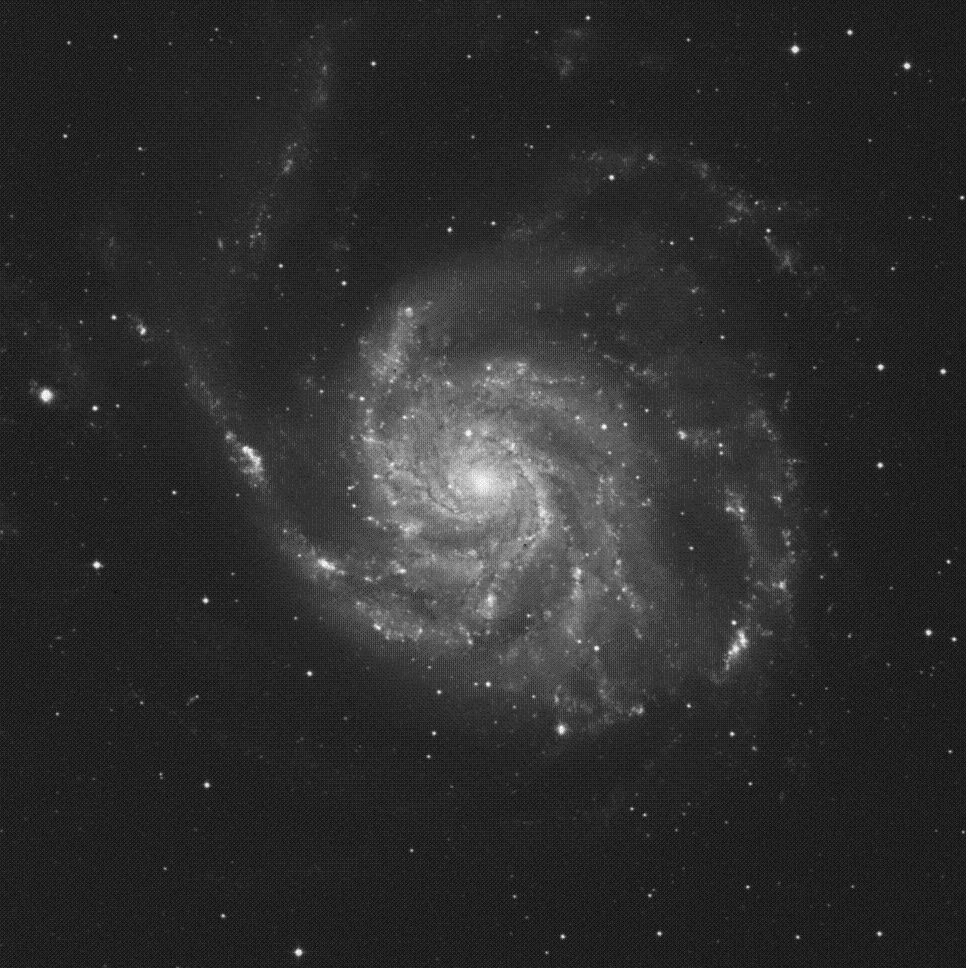Object Name: Messier 101
Alternative Designations: M101, NGC 5457, Pinwheel Galaxy
Object Type: Type Sc Spiral Galaxy
Constellation: Ursa Major
Right Ascension: 14 : 03.2 (h:m)
Declination: +54 : 21 (deg:m))
Distance: 27000 (kly)
Visual Brightness: 7.9 (mag)
Apparent Dimension: 22.0 (arc min)
Locating Messier 101: M101 is easily located by finding the first star (Eta) in the handle of the “Big Dipper” asterism in Ursa Major. It lays almost exactly the same distance north as the distance between Eta and the second star in the handle -Zeta. Simply form a mental triangle with the northern apex as your target position. From a good dark sky site, M101 can be spotted with larger binoculars as a vague, misty round patch – but doesn’t become apparent as a bright nucleus galaxy without the aid of a mid-sized telescope and show spiral structure to large aperture. Be aware that the outer edges are very vague and glimpses of patchy outside structure are actually star forming regions on Messier 101’s periphery. While the galaxy can be spotted under less than perfect sky conditions, it does require a good, dark night for serious study.
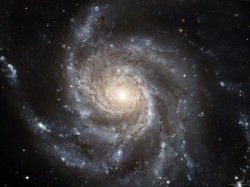 What You Are Looking At: At roughly 27 million light years away and spanning over 170,000 light years, Messier 101 is one of the biggest disc galaxies known so far. Shining with the light of about 30 billion suns, the Pinwheel galaxy is known as one of the most prominent Grand Design spiral galaxies in the sky – even if it is just a little lopsided… lopsided enough that Halton Arp has included M101 as No. 26 in his Catalogue of Peculiar Galaxies as a “Spiral with One Heavy Arm”. Why? Maybe because its interacting. According to Teresa Grabinska and Mirosaw Zabierowski; “We discuss Arp’s hypothesis that the HII regions are more numerous and more conspicuous on the side of a galaxy facing its companion. Arp’s hypothesis seems not to be true if we add to Hodge’s sets of galaxies only the most probably tidally-interacting cases.”
What You Are Looking At: At roughly 27 million light years away and spanning over 170,000 light years, Messier 101 is one of the biggest disc galaxies known so far. Shining with the light of about 30 billion suns, the Pinwheel galaxy is known as one of the most prominent Grand Design spiral galaxies in the sky – even if it is just a little lopsided… lopsided enough that Halton Arp has included M101 as No. 26 in his Catalogue of Peculiar Galaxies as a “Spiral with One Heavy Arm”. Why? Maybe because its interacting. According to Teresa Grabinska and Mirosaw Zabierowski; “We discuss Arp’s hypothesis that the HII regions are more numerous and more conspicuous on the side of a galaxy facing its companion. Arp’s hypothesis seems not to be true if we add to Hodge’s sets of galaxies only the most probably tidally-interacting cases.”
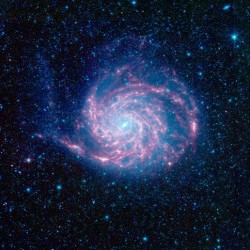 However, things get really interesting when we look at M101 with X-ray eyes. According to the work of Massimo Persic and Yoel Rephaeli: “Young galactic X-ray point sources (XPs) closely trace the ongoing star formation in galaxies… (The) relation provides the most adequate X-ray estimator of instantaneous SFR by the phenomena characterizing massive stars from their birth (FIR emission from placental dust clouds) through their death as compact remnants (emitting X-rays by accreting from a close donor).
However, things get really interesting when we look at M101 with X-ray eyes. According to the work of Massimo Persic and Yoel Rephaeli: “Young galactic X-ray point sources (XPs) closely trace the ongoing star formation in galaxies… (The) relation provides the most adequate X-ray estimator of instantaneous SFR by the phenomena characterizing massive stars from their birth (FIR emission from placental dust clouds) through their death as compact remnants (emitting X-rays by accreting from a close donor).
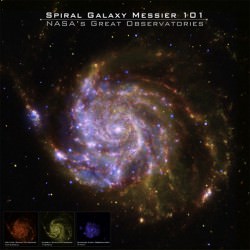 Of course, all this activity means an increase in supernovae, doesn’t it? Darn right. “A new multiepoch Ha imaging study of M101 (NGC 5457) has been carried out as part of a larger campaign to study the rate and stellar population of extragalactic novae. The survey yielded a total of 13 nova detections from 10 epochs of M101 observations spanning a 3 year period.” says E.A. Coelho (et al). “The spatial distribution of the combined nova sample from the present survey and from the earlier Shafter et al. survey shows that the specific frequency of novae closely follows the integrated background light of the galaxy.”
Of course, all this activity means an increase in supernovae, doesn’t it? Darn right. “A new multiepoch Ha imaging study of M101 (NGC 5457) has been carried out as part of a larger campaign to study the rate and stellar population of extragalactic novae. The survey yielded a total of 13 nova detections from 10 epochs of M101 observations spanning a 3 year period.” says E.A. Coelho (et al). “The spatial distribution of the combined nova sample from the present survey and from the earlier Shafter et al. survey shows that the specific frequency of novae closely follows the integrated background light of the galaxy.”
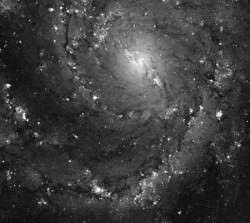 But there’s still plenty of mystery left to discover in Messier 101. “After a review of the discovery of external galaxies and the early classification of these enormous aggregates of stars into visually recognizable types, a new classification scheme is suggested based on a measurable physical quantity, the luminosity of the spheroidal component. It is argued that the new one-parameter scheme may correlate well both with existing descriptive labels and with underlying physical reality. Two particular problems in extragalactic research are isolated as currently most fundamental. A significant fraction of the energy emitted by active galaxies (approximately 1% of all galaxies) is emitted by very small central regions largely in parts of the spectrum (microwave, infrared, ultraviolet and x-ray wavelengths) that were previously inaccessible to observation.” says J.P. Ostricker.
But there’s still plenty of mystery left to discover in Messier 101. “After a review of the discovery of external galaxies and the early classification of these enormous aggregates of stars into visually recognizable types, a new classification scheme is suggested based on a measurable physical quantity, the luminosity of the spheroidal component. It is argued that the new one-parameter scheme may correlate well both with existing descriptive labels and with underlying physical reality. Two particular problems in extragalactic research are isolated as currently most fundamental. A significant fraction of the energy emitted by active galaxies (approximately 1% of all galaxies) is emitted by very small central regions largely in parts of the spectrum (microwave, infrared, ultraviolet and x-ray wavelengths) that were previously inaccessible to observation.” says J.P. Ostricker.
 “The physical processes by which regions with the volume of the luminous stellar parts of galaxies produce such enormous quantities of energy are currently the subject of much speculative debate. It appears that most of the mass of ordinary galaxies resides far from the central luminous region, with the volume containing most of this mass times the volume containing most of the light-emitting stars; the nature, amount, and extent of this mass are quite unknown. New instruments that will be operating in the next decade and that may be helpful in solving these two problems are briefly mentioned with particular emphasis on the advances expected in angular resolution at wavelengths for which picture-taking ability has historically been poor or nonexistent.”
“The physical processes by which regions with the volume of the luminous stellar parts of galaxies produce such enormous quantities of energy are currently the subject of much speculative debate. It appears that most of the mass of ordinary galaxies resides far from the central luminous region, with the volume containing most of this mass times the volume containing most of the light-emitting stars; the nature, amount, and extent of this mass are quite unknown. New instruments that will be operating in the next decade and that may be helpful in solving these two problems are briefly mentioned with particular emphasis on the advances expected in angular resolution at wavelengths for which picture-taking ability has historically been poor or nonexistent.”
History: The Pinwheel Galaxy was discovered by Pierre Mechain on March 27, 1781, and added as one of the last entries in Charles Messier’s catalog as M101. Messier writes: “Nebula without star, very obscure and pretty large, of 6 or 7 minutes [of arc] in diameter, between the left hand of Bootes and the tail of the great Bear [Ursa Major]. It is difficult to distinguish when one lits the [graticule] wires.”
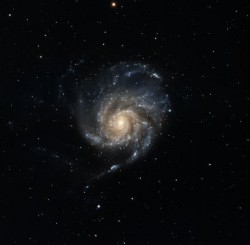 It would be Sir William Herschel who would shatter it into structure in 1783 when he writes in his unpublished notes: ” In the northern part is a large [bright] star pretty distinctly seen, and in the southern I saw 5 or 6 small [faint] ones glitter through the greatest nebulosity which appears to consist of stars. Evening bad. This and the 51st [M51] are both so far removed from the appearance of stars that it is the next step to not being able to resolve them. My new 20 feet will probably render it easy. On 1789, April 14 (Sw. 921). vB. SN. [very bright, small nucleus] with extensive nebulosity, pretty well determined on the preceding [W] side, but very diffuse to the north following [NE]. Includes the two following nebulae [III.788 and 789, NGCs 5461, 5462], and seems to extend 20′, perhaps 30′ or more.” Little did he know at the time he was actually picking up star forming regions!
It would be Sir William Herschel who would shatter it into structure in 1783 when he writes in his unpublished notes: ” In the northern part is a large [bright] star pretty distinctly seen, and in the southern I saw 5 or 6 small [faint] ones glitter through the greatest nebulosity which appears to consist of stars. Evening bad. This and the 51st [M51] are both so far removed from the appearance of stars that it is the next step to not being able to resolve them. My new 20 feet will probably render it easy. On 1789, April 14 (Sw. 921). vB. SN. [very bright, small nucleus] with extensive nebulosity, pretty well determined on the preceding [W] side, but very diffuse to the north following [NE]. Includes the two following nebulae [III.788 and 789, NGCs 5461, 5462], and seems to extend 20′, perhaps 30′ or more.” Little did he know at the time he was actually picking up star forming regions!
However, by 1837 Admiral Smyth was beginning to get a clue. Says he: “This object was discovered by Mechain in 1781, in whose instruments it was very obscure; and it only exhibited a mottled nebulosity to WH [William Herschel]. Under a very favourable view it is large and well spread, though somewhat faint except towards the center, where it brightens. There are several telescopic stars in the field, one of which is very close to the nebula. From the nature of this neighborhood, and a trifling uncertainty in the earlier data, this object may be 214 H I [this is actually NGC 5474]; but that astronomer does not appear to have been aware of the identity. It is one of those globular nebulae that seem to be caused by a vast agglomeration of stars, rather than by a mass of diffused luminous matter; and though the idea of too dense a crowd may intrude, yet the paleness tells of its inconceivable distance, and probable discreteness.”
May you enjoy your 27 million light year journey into M101 as much!
Top M101 image credit, Palomar Observatory courtesy of Caltech, M101 Hubble Image, Messier 101 in UV by Ultraviolet Imaging Telescope (UIT and NASA), NASA’s Spitzer Space Telescope, Composite M101 as Viewed by Spitzer, Hubble and Chandra, Hubble B&W image and M101 image courtesy of George Jacoby, Bruce Bohannan, Mark Hanna/NOAO/AURA/NSF.

